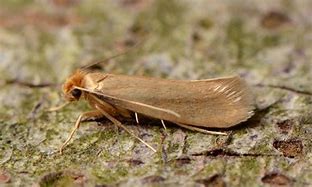Clothes Moths – Webbing Clothes vs. Casemaking Clothes Moths
The title sounds a bit like a bad sci-fi movie. Clothes moths are pests that can destroy fabric and other materials. They feed exclusively on animal fibers, especially wool, fur, silk, feathers, felt, and leather. These materials contain keratin, a fibrous protein that the worm-like larvae of the clothes moth can digest. (In nature, these larvae feed on the nesting materials or carcasses of birds and mammals.) Cotton and synthetic fabrics such as polyester and rayon are rarely attacked unless blended with wool, or heavily soiled with food stains or body oils. Serious infestations of clothes moths can develop undetected in dwellings, causing irreparable harm to vulnerable materials.
Facts about Clothes Moths
Clothes moths are small, 1/2-inch moths that are beige or buff-colored. They have narrow wings that are fringed with small hairs. They are often mistaken for grain moths infesting stored pantry food items in kitchens. Unlike some other types of moths, clothes moths are seldom seen because they avoid light. They prefer dark, undisturbed areas such as closets, basements, and attics. Similar-looking moths spotted in kitchens and other well-lighted areas are possibly grain moths originating from cereals, dried fruit, nuts, or other stored foods.

Courtesy Butterfly Conservatory
Two different types of clothes moths are common in North America — the webbing clothes moth and the casemaking clothes moth. Adult webbing clothes moths are a uniform, buff-color, with a small tuft of reddish hairs on top of the head.

Webbing Clothes Moth – Courtesy of Mothidentification.com
Casemaking clothes moths are similar in appearance but have dark specks on the wings. Clothes moth adults do not feed so they cause no injury to fabrics. However, the adults lay about 40-50 pinhead-sized eggs on vulnerable substrates, which in turn, hatch into the fabric-eating larvae. Often casemaking clothes moths are mistaken for grain-infesting moths, such as the Indianmeal moth.

Casemaking Clothes Moth Courtesy of Bugguide.net
It is important to recognize that damage attributed to clothes moths may in fact be caused by another group of insects adapted to digesting keratin— carpet beetles. Carpet beetles are very common in homes and buildings, and feed on most of the same materials as clothes moths. However, these pests are quite different in appearance.
Common Locations
As noted earlier, clothes moths feed on such animal-derived materials as wool, fur, silk, feathers, and leather. Articles commonly infested include sweaters, scarves, coats, blankets, rugs, down pillows and comforters, upholstery, toys, decorative items, and taxidermy mounts. The larvae prefer to feed in dark, undisturbed areas such as closets, chests, and boxes where woolens and furs are stored for long periods. Clothing and blankets in regular use are seldom infested, nor are rugs that get a normal amount of traffic or are routinely vacuumed. Edges and undersides of rugs, or sections beneath furniture are more likely to be attacked.
Clothes moths may also be found infesting upholstered furniture (both inside and out), and in vents and ducts where the larvae may be feeding on lint, shed pet hair and other bits of debris. Infestations may also originate from bird nests or animal carcasses present in attics, chimneys, or wall cavities.
Controlling Current Infestations
Controlling clothes moths requires a thorough inspection to locate all infested items. The primary source may be a wool scarf or fur/felt hat at the back of a closet, an old rug stored in the basement, or an abandoned bird or squirrel nest up in the attic. Larvae prefer to feed in dark, undisturbed areas where woolens and other susceptible items are stored for long periods. When inspecting clothing, pay attention to seams, folds, and creases (e.g., cuffs and collars) where larvae often prefer to feed.
Larvae also may be found along and beneath edges of rugs and carpeting. Use needle-nose pliers to lift the outer edge of wall-to-wall carpet from the tack strip along baseboards. Other possible locations include beneath/within upholstered furniture or inside heat ducts and floor vents with accumulations of pet hair and lint. Occasionally, infestations may originate from bird or animal nests in an attic, chimney, or wall cavity.
Infested items and susceptible articles nearby should be laundered, dry-cleaned, or discarded. Bagging heavily infested items before disposal can help prevent further spread of the moths. Dry-cleaning or hot laundering kills any eggs or larvae that may be present. Heat generated by a clothes dryer is effective as well. Vacuuming floors, carpets, and inside heating vents effectively removes larvae as well as hair and lint, which could support future infestations. Be sure to vacuum along and beneath edges of carpets, along baseboards, underneath furniture and stored items, and inside closets and quiet areas where clothes moths (as well as carpet beetles) prefer to feed.
Preventing Future Infestations
Woolens and other susceptible items should be dry-cleaned or laundered before being stored for long periods. Cleaning kills any eggs or larvae that may be present and removes perspiration odors that tend to attract pests. Articles to be stored should then be packed in tight-fitting plastic bags or containers.
Householders intending to use moth-deterring balls, flakes or crystals should carefully read and follow label directions. These volatile, odiferous products containing naphthalene or paradichlorobenzene can be hazardous if used incorrectly. Never scatter them in open closets or other areas where children or pets can reach them. The vapors from these materials are only effective if maintained at sufficient concentrations. Effective concentrations can best be achieved by sealing susceptible items (with the manufacturer’s recommended dosage of balls, flakes, or crystals) in large plastic bags within in tight-fitting trunks, totes, or boxes.
Valuable garments such as furs can also be protected from clothes moths by storing them in cold vaults, a service offered by some furriers and department stores. Contrary to popular belief, cedar closets or chests are seldom effective in deterring clothes moths because the seal is insufficient to maintain lethal or repellent concentrations of the volatile oil of cedar.
